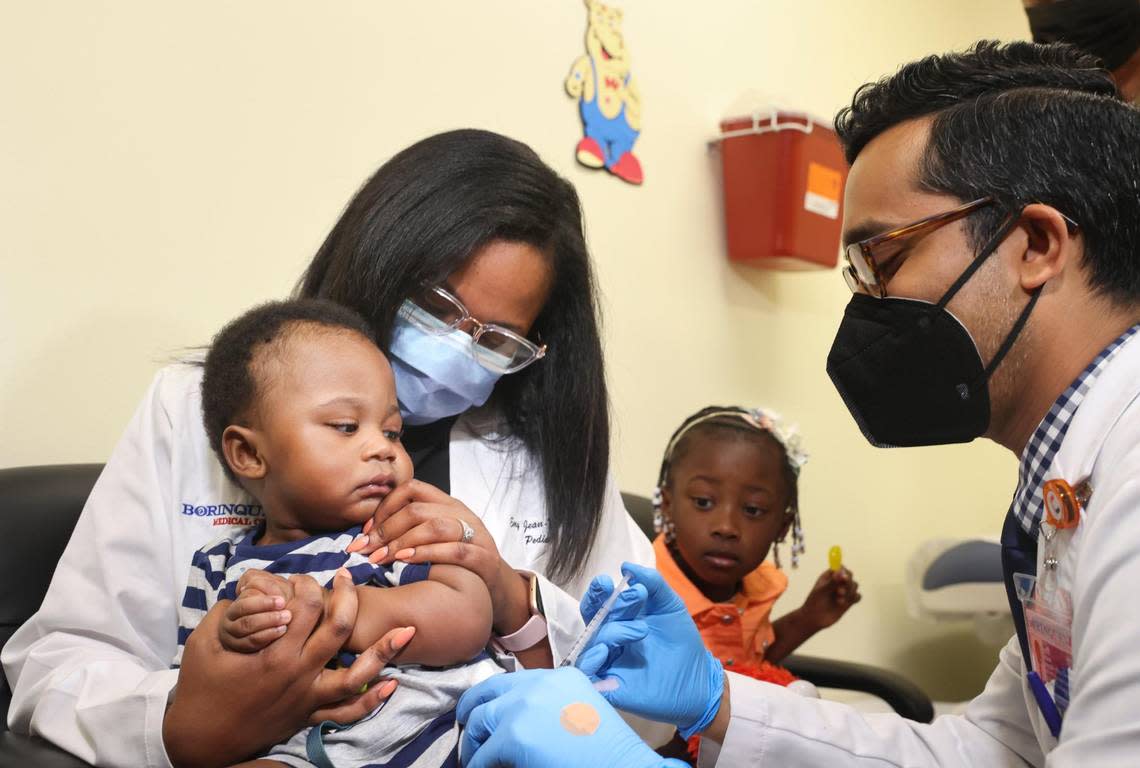Florida COVID weekly update: New cases slightly decrease for first time in over a month

What is the COVID-19 situation like in Florida?
The average number of cases and deaths per day decreased in the latest seven-day period in the state. As of Thursday, Jan. 5, the state has added an average of 3,320 cases and 16 deaths per day in the past seven days, according to Miami Herald calculations of data published by the U.S. Centers for Disease Control and Prevention. That’s down from an average of 3,691 cases and 44 deaths per day in the previous seven-day period.
This is the first dip in weekly new cases since late November, when the seven-day case average was 1,665.
READ MORE HERE: What’s the COVID situation in Miami and why are Florida hospitals full of patients?
As of Friday, Jan. 6, more than 14,855,000 people were fully vaccinated in Florida. The state has logged at least 7,361,744 cases and 84,015 deaths since the pandemic began in March 2020.
The number of cases is likely an undercount because the data doesn’t include positive results from at-home COVID testing. The state tracks only resident cases and deaths, excluding nonresident information.
Here’s a breakdown of what to know this week:
Tracking COVID variants
The CDC is tracking 17 omicron subvariants, 13 of which are spreading throughout the United States and make up all new cases.
From Jan. 1 to Jan. 7, the BQ.1.1 strain was the most dominant strain in the United States, accounting for 34.4% of cases. The XBB.1.5 variant is now the second-most dominant strain, accounting for 27.6% of cases, according to CDC data.
In the Southeast region, which includes Florida, BQ.1.1 made up 43.5% of cases and was the most dominant strain, while BQ.1 was the second-most dominant, accounting for 19.9% of the cases.
COVID spread in South Florida
In the past week, the COVID-19 risk level in Miami-Dade County remained high.
At this level, the CDC recommends wearing a high-quality mask. For those at high risk of getting very sick, the agency says to consider avoiding non-essential indoor activities in public.
Manatee County raised to a medium transmission level in the last week, joining Broward, Monroe and Palm Beach counties.
At this level, the CDC recommends those at high risk of severe illness talk with their doctors on whether to wear a mask or take other precautions.
South Florida and Manatee County COVID-19 Cases
From Dec. 29 to Jan. 5 Florida recorded 23,241 new cases, according to Miami Herald calculations of the CDC’s Community Profile Report published Friday.
Here’s a breakdown of the new COVID cases in South Florida and Manatee County, according to the report.
▪ Miami-Dade reported 5,581 new resident cases in the week ending Jan. 5, reaching a cumulative total of 1,506,907 since March 2020, when the pandemic began. New cases were 23.41% lower than those added in the previous week, and COVID-19 testing decreased by 17.7%.
▪ Broward reported 2,185 new resident cases, reaching a cumulative total of 754,523. New cases were 22.63% lower than those added in the previous week, and COVID-19 testing decreased by 9.89%.
▪ Palm Beach reported 1,474 new resident cases, reaching a cumulative total of 466,530. New cases were 24.56% lower than those added in the previous week, and COVID-19 testing decreased by 12.52%.
▪ Monroe reported 53 new resident cases, reaching a cumulative total of 22,344. New cases stagnated in the previous week, and COVID-19 testing increased by 0.36%.
▪ Manatee reported 306 new resident cases, reaching a cumulative total of 120,318. New cases were 12.32% lower than those added in the previous week, and COVID-19 testing decreased by 9.88%.
South Florida and Manatee County COVID deaths
Florida has added 109 deaths in the past week, according to Miami Herald calculations of the CDC’s Community Profile Report.
It is unclear when these newly reported deaths occurred. The Community Profile Report updates Florida’s county death tolls and rates about once every seven days.
Florida had a rate of 391 cumulative deaths per 100,000 people since the start of the pandemic, according to the CDC report.
Here’s where death rates and tolls stand in South Florida and Manatee County, according to the CDC:
▪ Miami-Dade’s death toll is 12,035, an increase of 22 deaths from last Friday’s report. That’s a rate of 443 cumulative deaths per 100,000 people since the beginning of the pandemic.
▪ Broward’s death toll is 6,571, an increase of six. That’s a rate of 336 cumulative deaths per 100,000 people.
▪ Palm Beach’s death toll is 5,828, an increase of 10. That’s a rate of 389 cumulative deaths per 100,000 people.
▪ Monroe’s death toll is 134, it saw no new increases. The county would be at a death rate of 181 deaths per 100,000 people if its population were that large.
▪ Manatee’s death toll is 1,684, an increase of two. Manatee has a rate of 418 cumulative deaths per 100,000 people.
Florida COVID-19 vaccinations
About 14,855,016 eligible Floridians — 69.2% of the state’s population — have completed the two-dose series of either the Pfizer-BioNTech or Moderna vaccines or have completed Johnson & Johnson’s single-dose vaccine, according to the CDC.
Here’s how many people have received the updated Pfizer-BioNTech booster in South Florida and Manatee County since Oct. 12, according to the CDC:
▪ In Miami-Dade, about 169,655 people, or 6.6% of the fully vaccinated population, have received the booster.
▪ In Broward, about 171,925 people have received the booster, or 9.3% of the fully vaccinated population.
▪ In Palm Beach, about 169,208 people have received the booster, or 11.9% of the fully vaccinated population.
▪ In Monroe, about 8,764 people have received the booster, or 12.4% of the fully vaccinated population.
▪ In Manatee, about 47,137 people have received the booster, or 12.2% of the fully vaccinated population.
